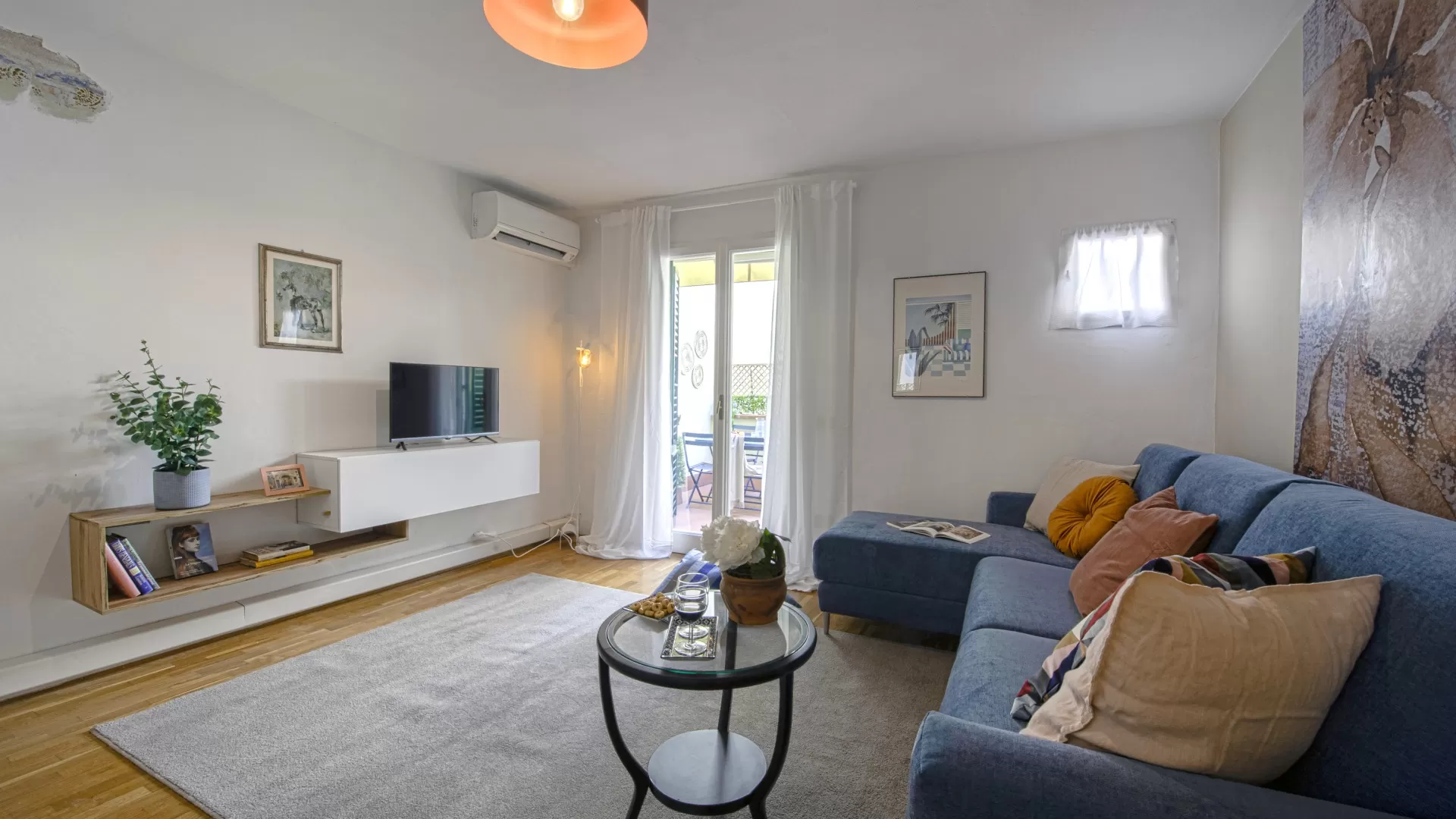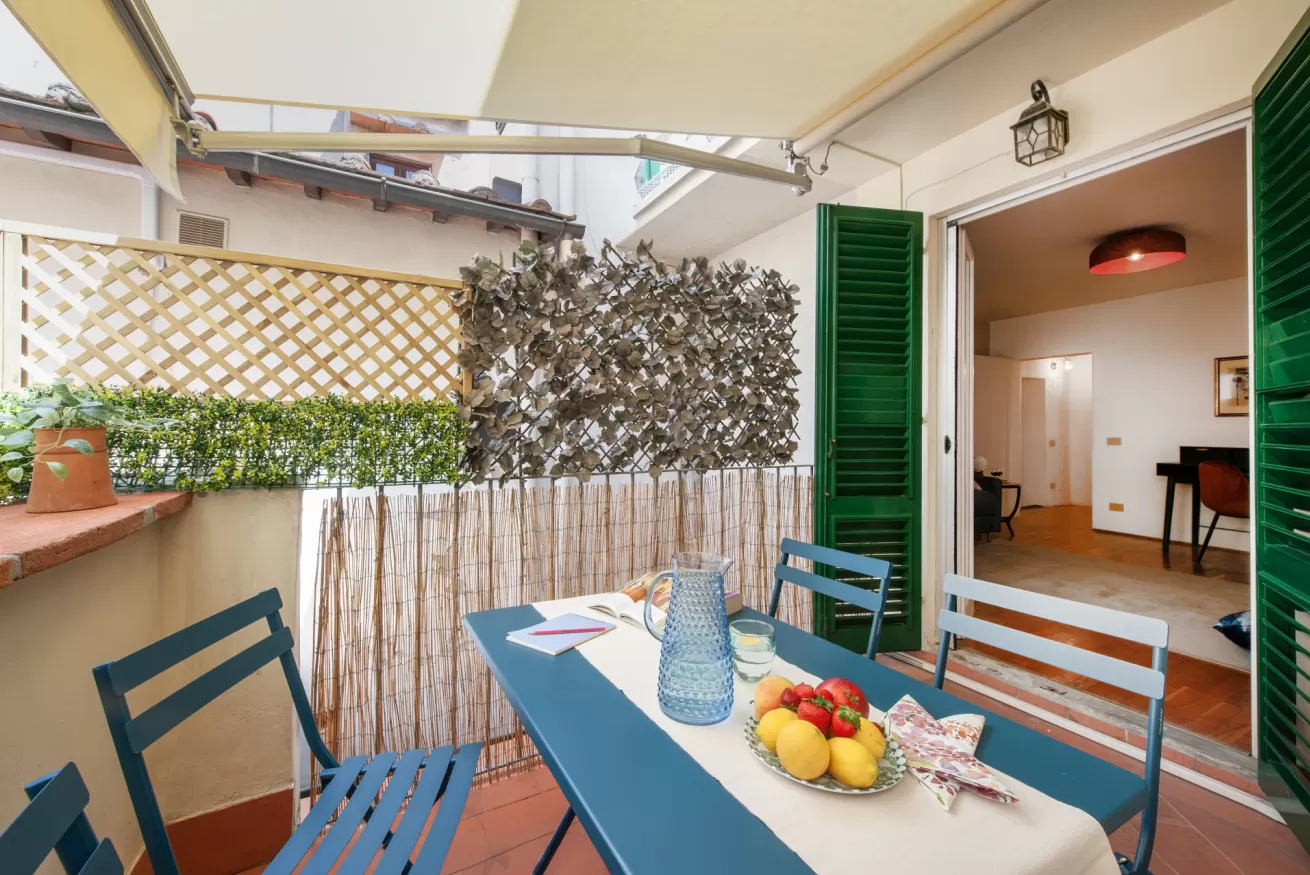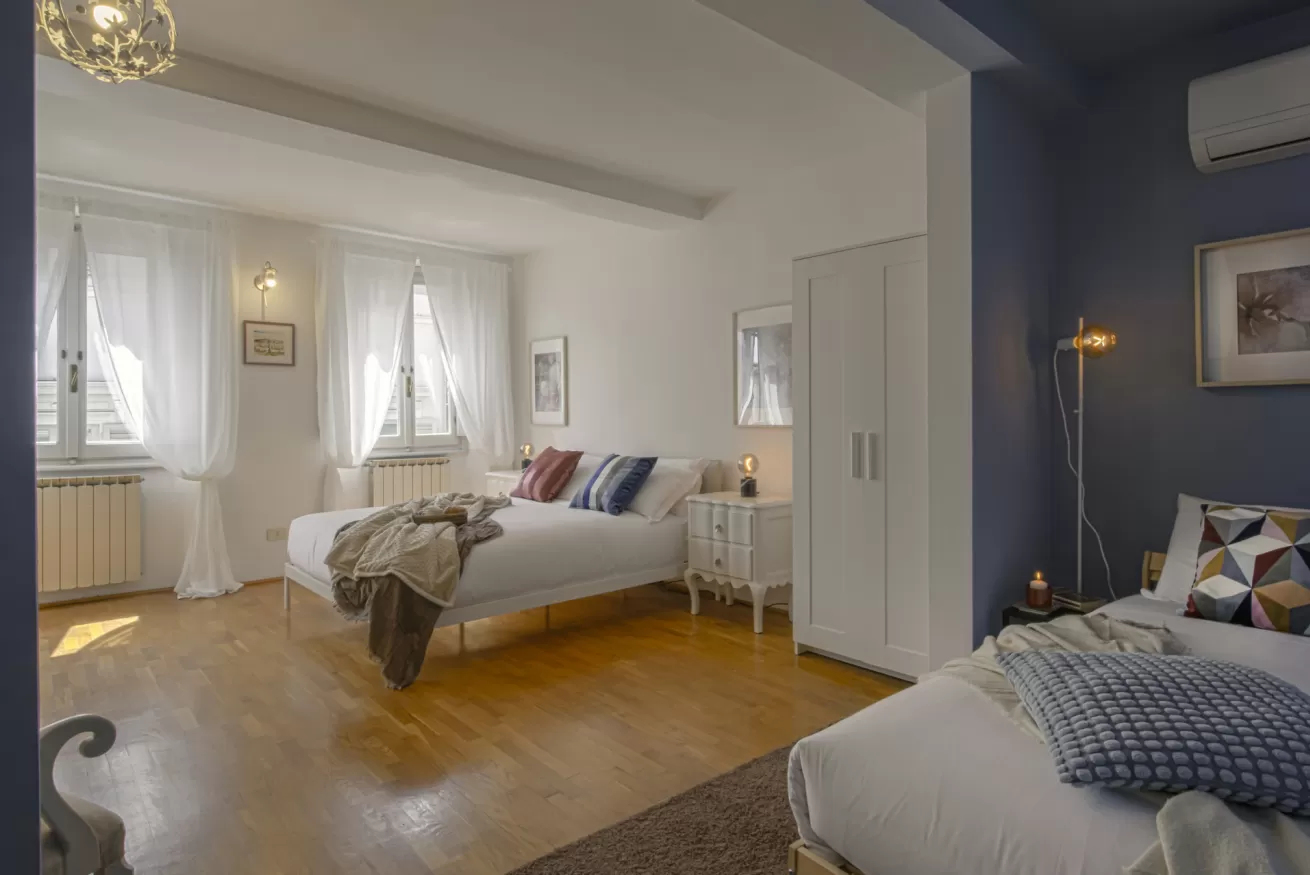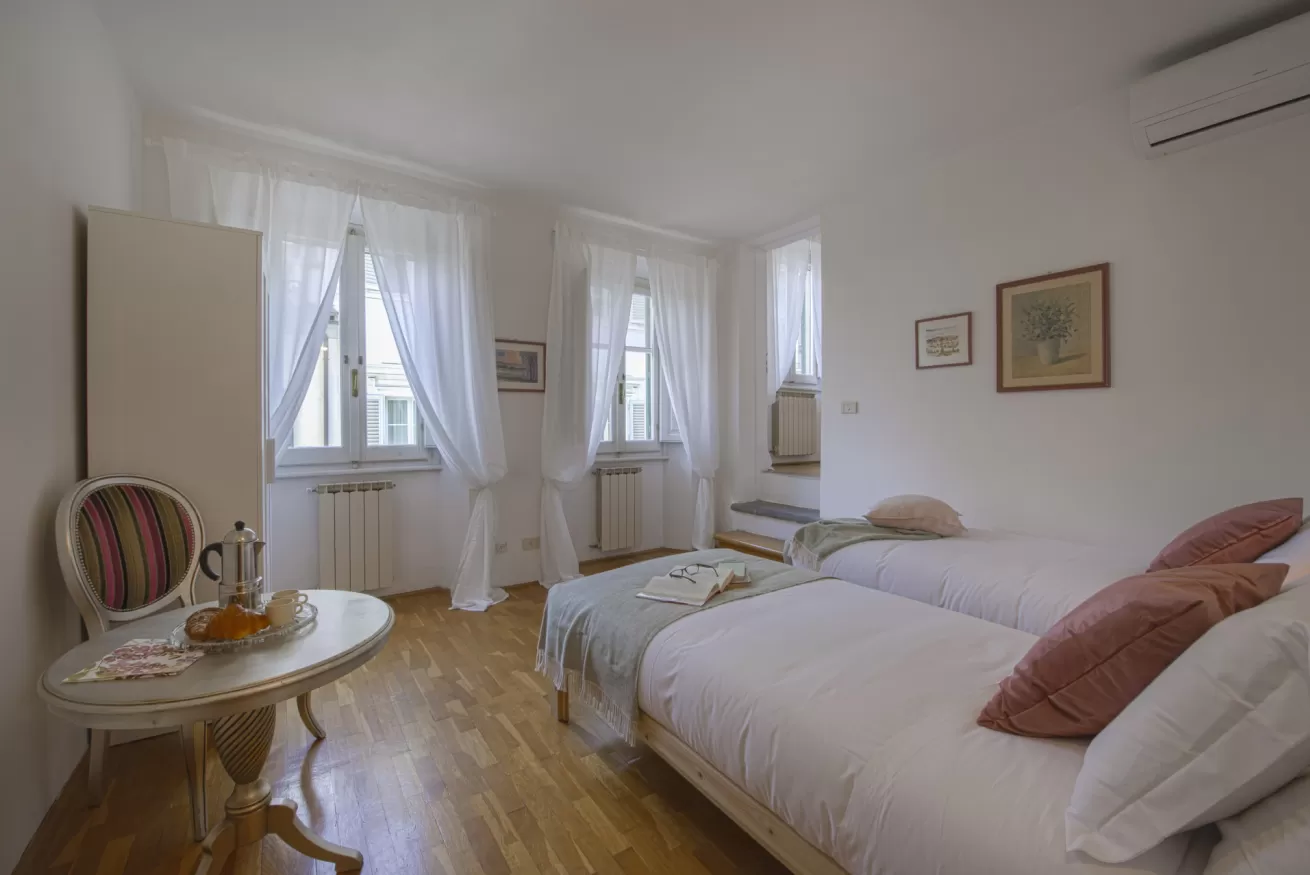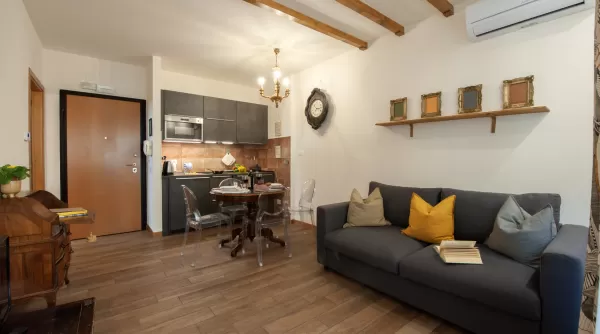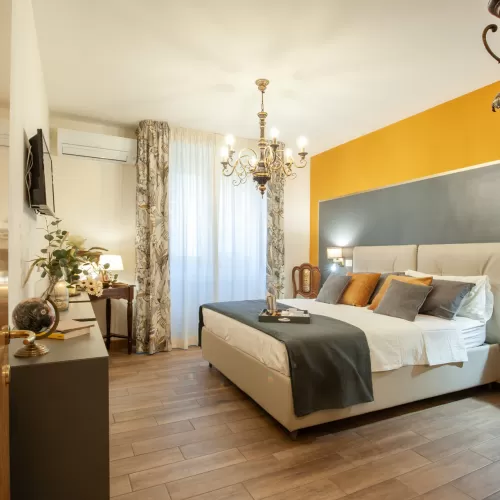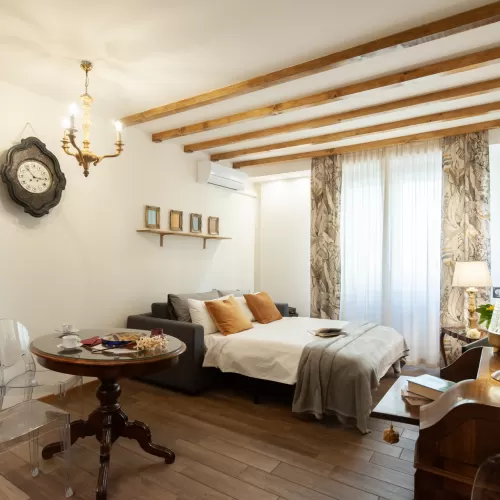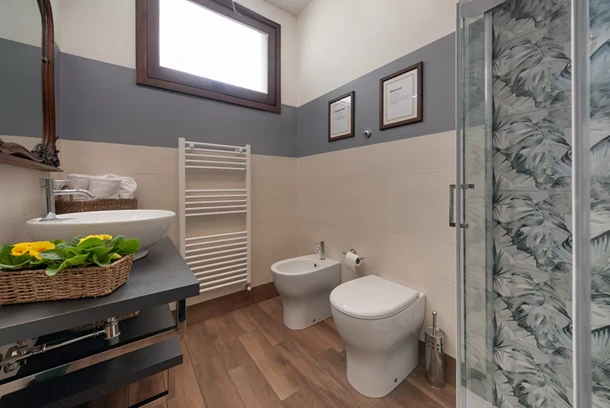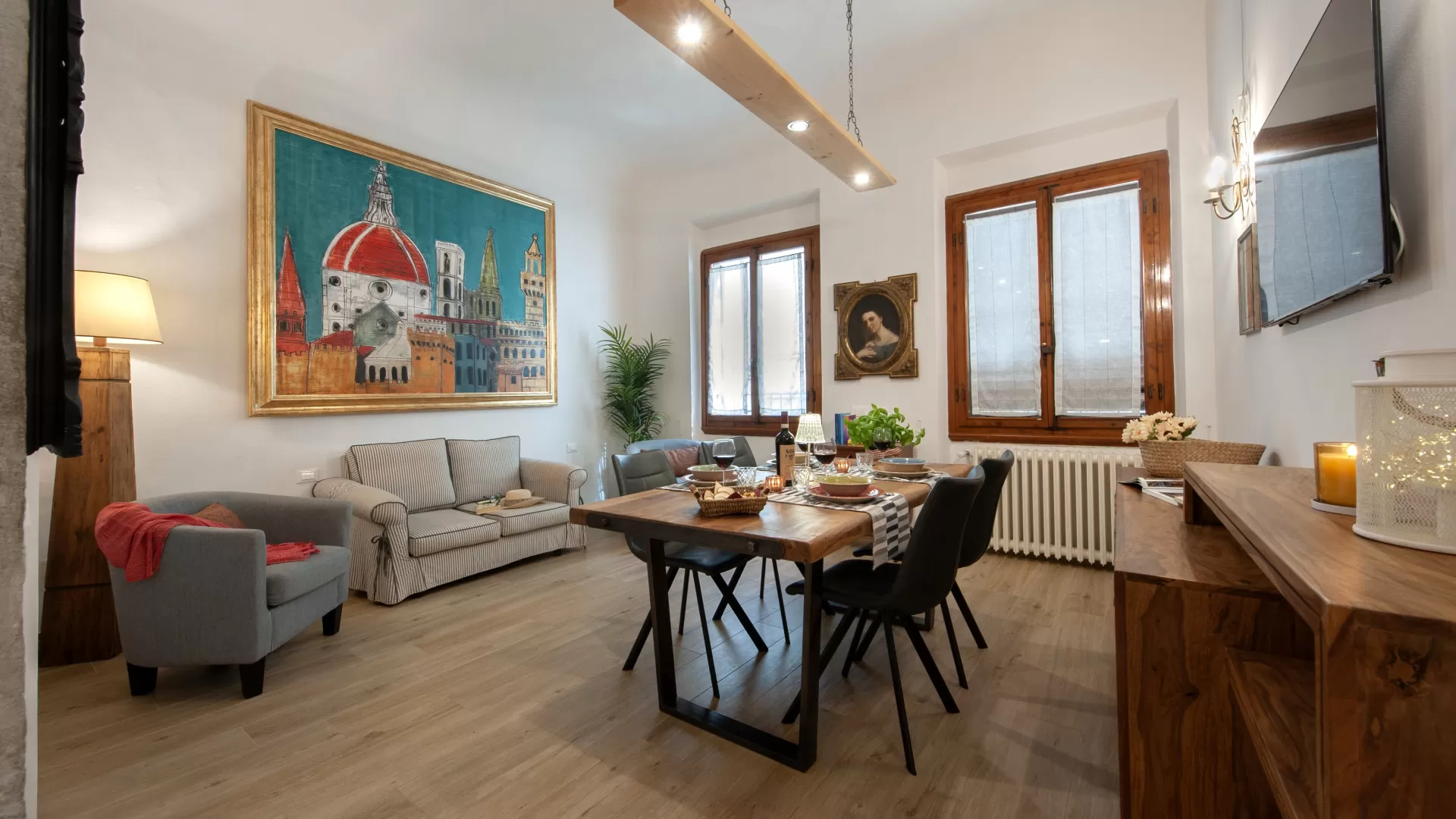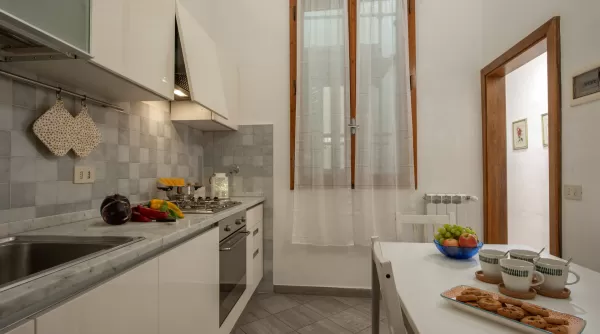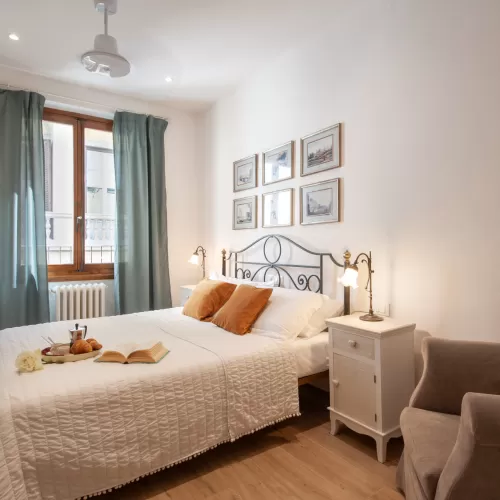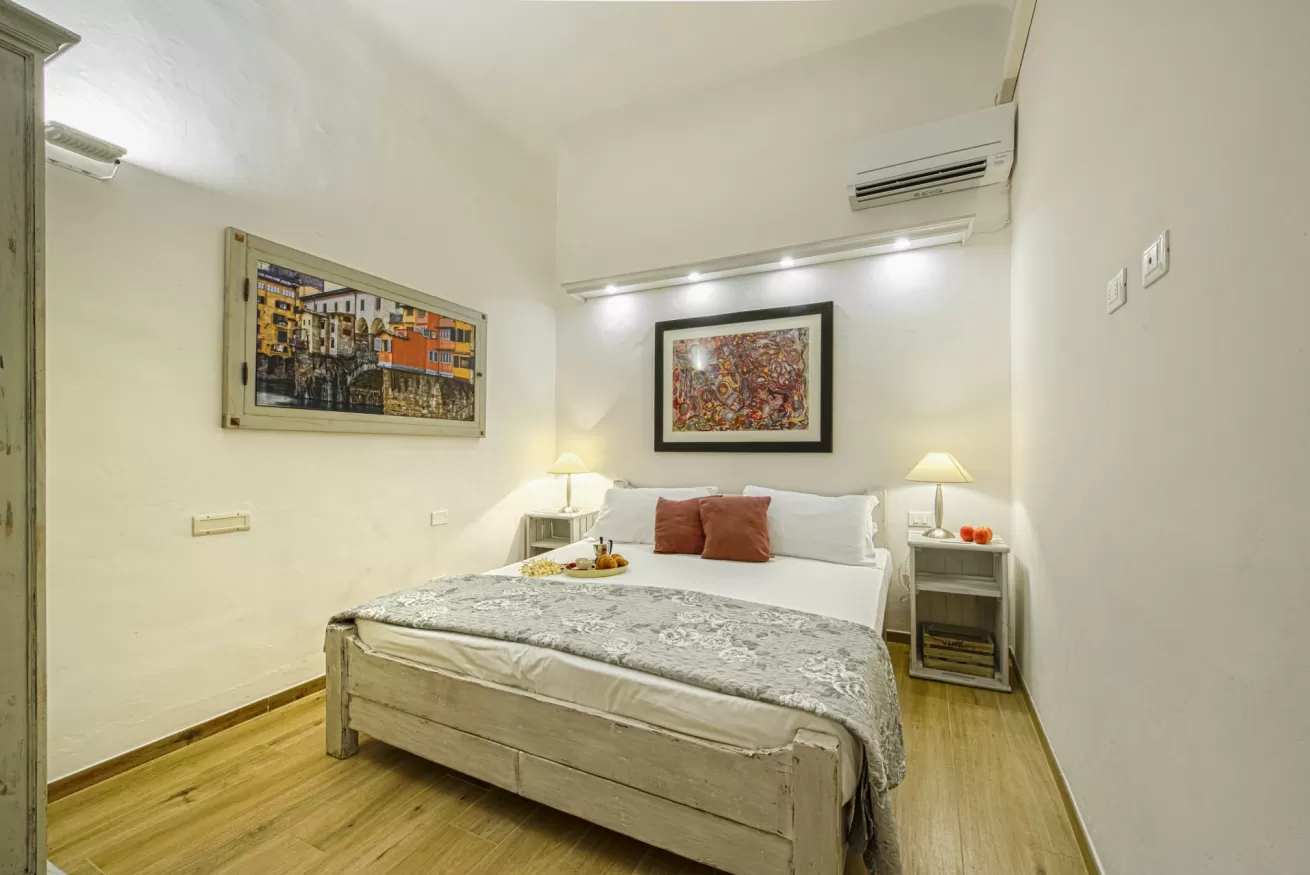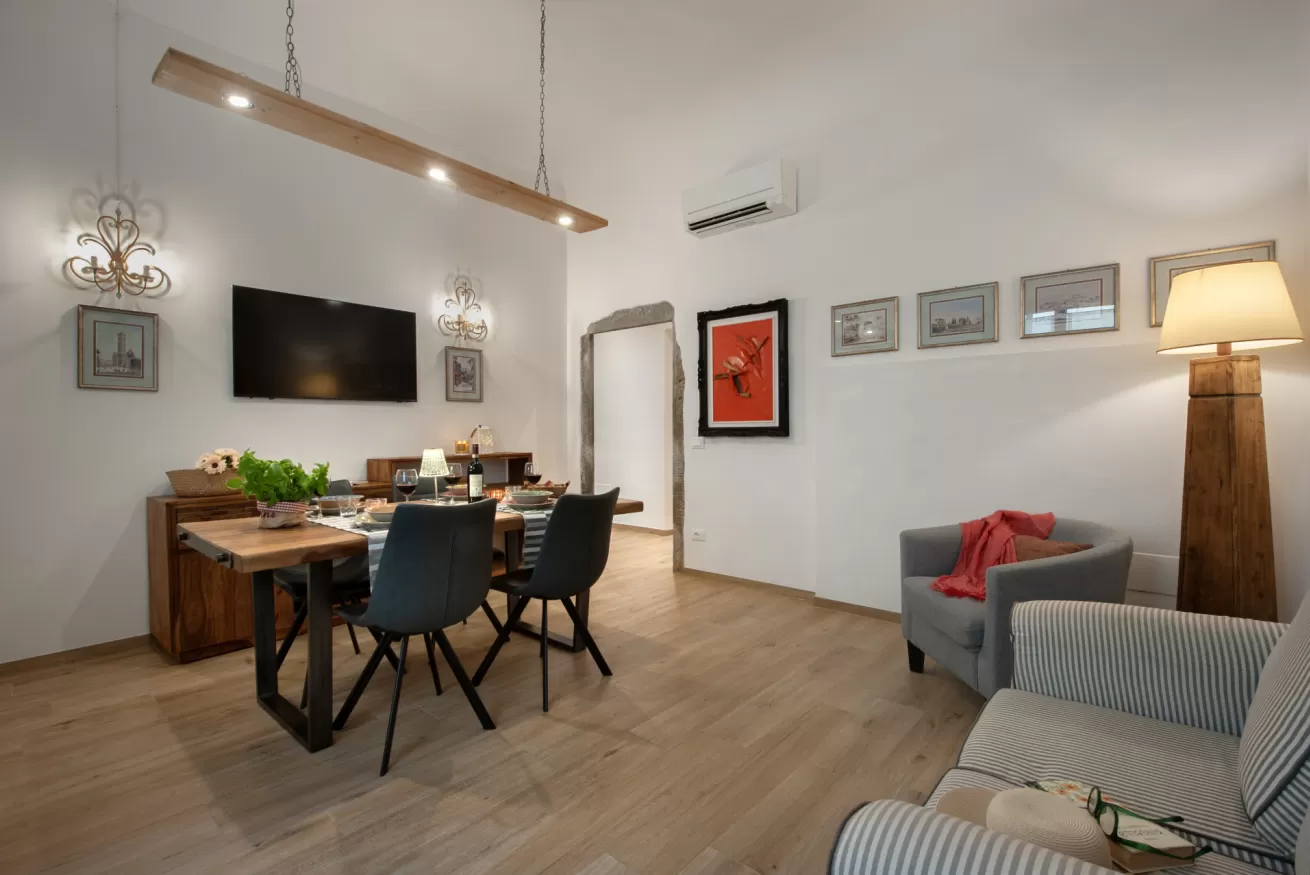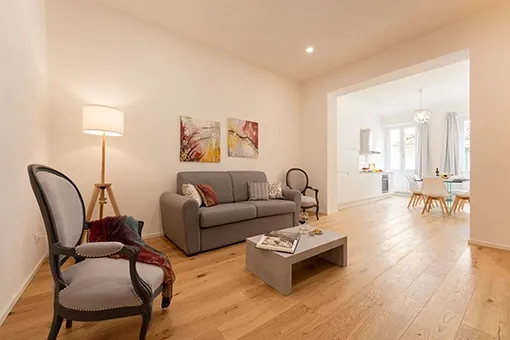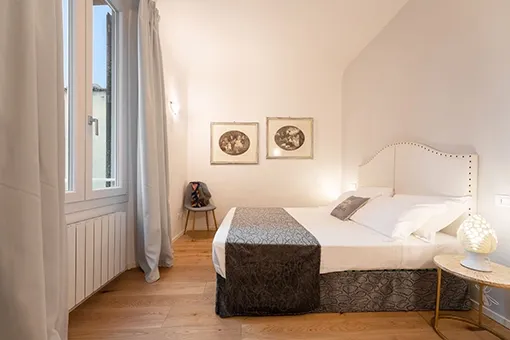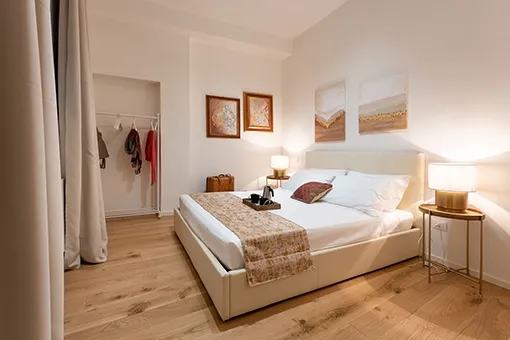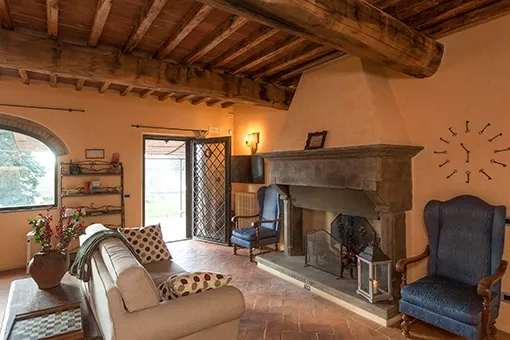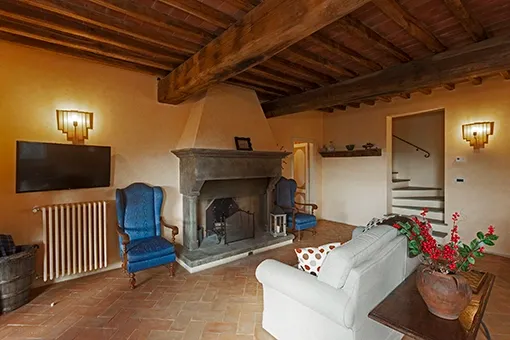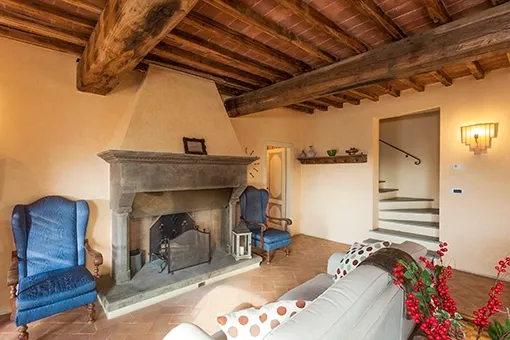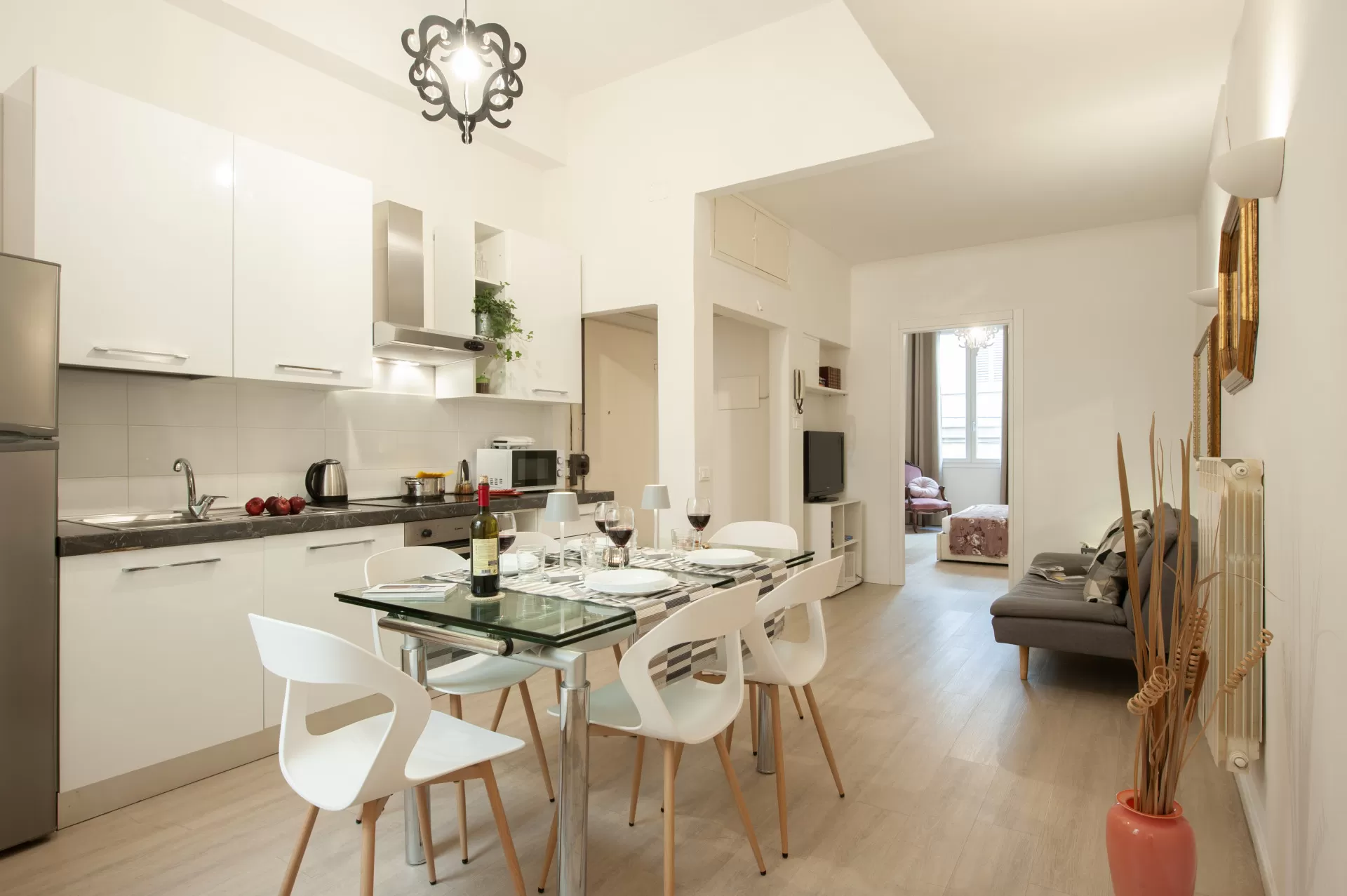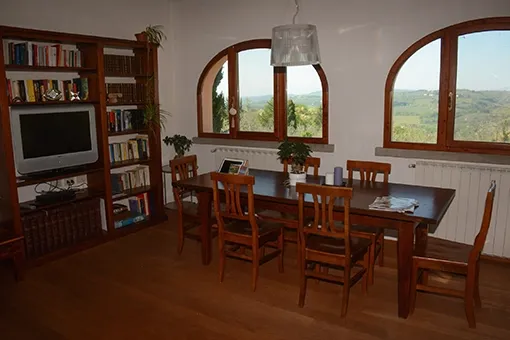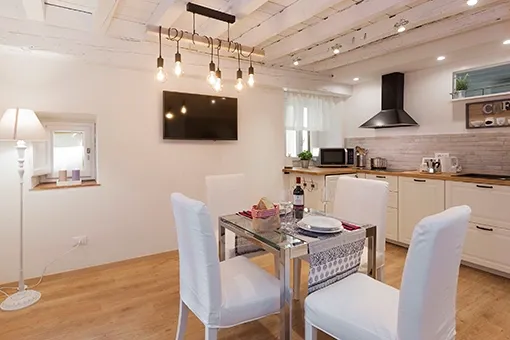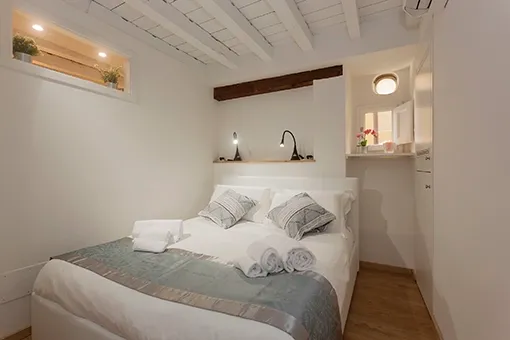Florence and Chianti Area
This is the advice of Flo Apartments. Let yourself be captured by the beauty of Tuscany, where every corner has a story to tell.
What to visit in Florence?
Florence is a city rich in art and culture that offers many attractions to visit!
The city is known worldwide for its historic centre, which was declared a UNESCO World Heritage Site in 1982. One of the most striking sights is the Cathedral of Santa Maria del Fiore, with its distinctive Dome, designed by Brunelleschi, and Giotto’s bell tower.The Uffizi Gallery, which houses some of the most important works of art of the Renaissance, is another must-see attraction. The Pitti Palace and Boboli Gardens offer a unique insight into Renaissance aristocratic life, while the Ponte Vecchio is an iconic spot with jewellery shops and traditional crafts.
For those interested in religious history, the Basilica di Santa Croce is an interesting stop, as it houses the tombs of figures such as Michelangelo, Galileo and Machiavelli.

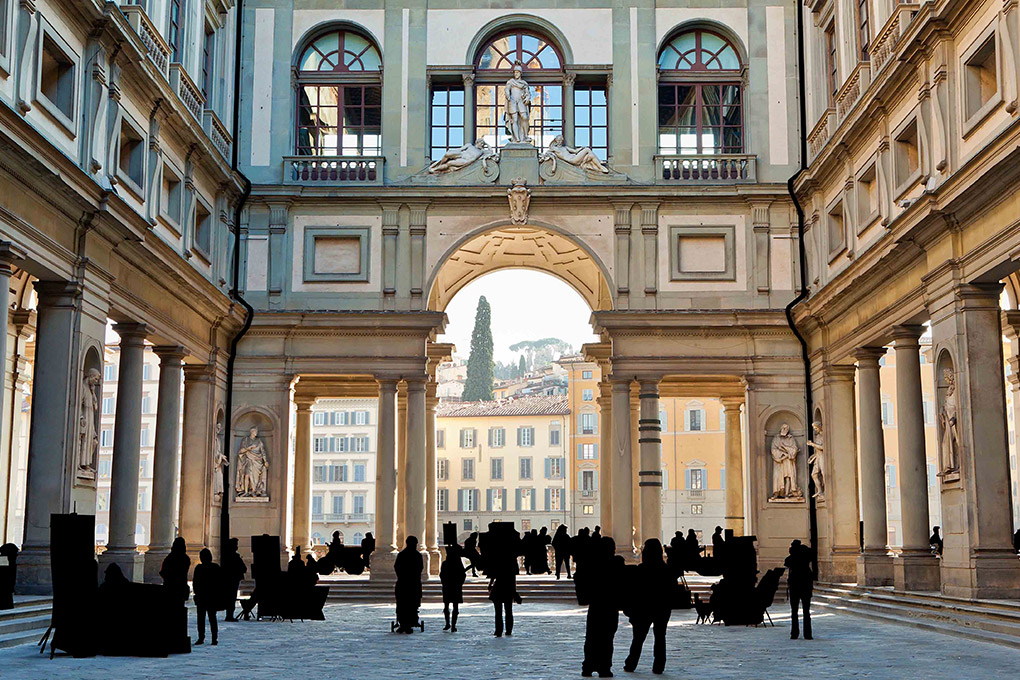
Main museums in Florence?
The city of Florence boasts several of the most important museums in the world. One of the best known museums is the Uffizi Gallery, which houses some of the most important works of art of the Renaissance, including Botticelli’s Birth of Venus and Leonardo da Vinci’s Annunciation.
Another museum not to be missed is the Galleria dell’Accademia, which houses Michelangelo’s famous David, along with other works by the artist.
The Museo di Palazzo Pitti, surrounded by the stunning Boboli Garden is one of the largest art museums in Italy, housing several collections, including the Galleria Palatina, the Galleria d’Arte Moderna and the Museo della Moda e del Costume.
The Museo dell’Opera del Duomo is another important museum housing works of art from the Cathedral of Santa Maria del Fiore and its bell tower.
Last but not least, the Museo Nazionale del Bargello is a museum of medieval and Renaissance art housing sculpture, jewellery and metal art objects.


What activities to do in 3 days in Florence?
If you only have three days to visit Florence, we suggest you to plan an itinerary that allows you to make the most of your time.
DAY 1
Your first day in Florence could start with a visit to the Cathedral of Santa Maria del Fiore, with its imposing dome designed by Brunelleschi, and Giotto’s Campanile, if you feel up to climbing about 400 steps. Then you could visit the Museo dell’Opera del Duomo, which houses works of art from the Cathedral of Santa Maria del Fiore and its bell tower.DAY 2
On the second day, we recommend a visit to the Uffizi Gallery, where you can admire some of the most important works of art of the Renaissance, including Botticelli’s Birth of Venus.
Don’t miss the Accademia Gallery, where you can admire Michelangelo’s famous David.
And perhaps a visit to the Basilica of Santa Croce, where the tombs of illustrious figures such as Michelangelo, Galileo and Machiavelli are located. Finally, end your day with a visit to the Bargello National Museum, a museum of medieval and Renaissance art that houses works of sculpture, jewellery and metal art objects.DAY 3
On the third day you could take a walk along the Arno River and visit the Ponte Vecchio, one of the symbols of Florence, known for its jewellery and gold shops.
You are in the Oltrarno, so you could visit the Palazzo Pitti Museum, one of the largest art museums in Italy, which houses several collections, including the Galleria Palatina and the Fashion and Costume Museum. Finally, end your day with a stroll through the Boboli Gardens, a beautiful Renaissance-era park that offers a panoramic view over the city.These are just a few examples of what you can do in three days in Florence. The city offers many other attractions, so be sure to plan your itinerary according to your interests and preferences.
Where are the most scenic points in Florence?
Florence offers numerous vantage points where you can enjoy breathtaking views of the city.
One of the most famous stunning points is the terrace of Piazzale Michelangelo, located on the hill just outside the historical centre. From here, a 360-degree view of the city can be admired, with the Cathedral of Santa Maria del Fiore and the Arno river stretching as far as the surrounding hills.Another popular vantage point is the tower of Palazzo Vecchio, where you can climb to admire the view from the top.
Last but not least, the Bardini Garden is another scenic spot offering a panoramic view of the city, with the Duomo standing majestically in front of you.

What type of transport should be used for travel in Florence?
Florence is a relatively small city and our apartments are within walking distance of the main attractions. However, there are several means of transport available for tourists.
Buses are one of the most widely used forms of public transport in Florence, with numerous routes covering most of the city. They are convenient and frequent, but can be very crowded at peak times.
Another option is to take the tram, which runs a main line from north to the city center, with numerous stops at strategic points such as Santa Maria Novella station and Amerigo Vespucci Airport.
There are several bike hire companies in the city and bikes are a popular way to get around Florence.
Taxis are available throughout the city, but as they are in high demand, we recommend you book them.
Which are the most 'unusual' destinations in Florence?
Here is a selection of five hidden corners away from the crowded tourist areas of the Tuscan capital.
BOBOLINO GARDEN
Located just outside Porta Romana, at the top of the long viale Niccolò Machiavelli. This wonderful historic street in Florence leads to a truly peaceful and serene place. Along the path to the top of the hill are small parks with benches and fountains.
From the Bobolino Garden there is a winding path that leads to Piazzale Galileo. Continuing on, you reach the famous basilica of San Miniato al Monte and Piazzale Michelangelo which, besides offering a spectacular view over the rooftops of Florence, is a terminus for several buses.PORTA ROMANA
Porta Romana is part of the ancient city walls, dating back to the 14th century, and is the largest and best preserved in Florence. This entrance still retains the original wooden doors and a marble slab with the Medici coat of arms. From here begins Via Romana, which leads to the historic centre of Florence.BORGO SAN FREDIANO
San Frediano is one of the ‘coolest’ neighbourhoods in Florence, also called the Artisans and Artists’ Quarter, full of stories to tell and emotions to experience.
It represents the most authentic area of the city, where the old Florentine traditions live on with their typical workshops, in which one can still see various artisans and artists at work.
It is bordered by Porta San Frediano, another ancient city gate.
Strolling through the famous Piazza del Carmine, which houses a jewel of Florentine art, the Brancacci Chapel, we arrive at Piazza Santo Spirito, a very picturesque square with its open-air market.
This is a historic area of Florence that most tourists do not visit, yet it is very characteristic and authentic. Here there are numerous typical restaurants serving the best specialities of Tuscan cuisine.SAN NICCOLÒ
This charming neighbourhood is home to one of the oldest churches in Florence, the Church of San Niccolò. Situated close to the Arno river, the church has suffered two devastating floods: one in 1557 and the infamous flood of 1966. On both occasions it was badly damaged but still stands.I suggest an itinerary that I took one evening at sunset, perfect for a pleasant walk.
Starting from Piazza de’ Mozzi, take the road on the right, Via de’ Bardi. At the crossroads, turn left towards Costa Scarpuccia; you will come to a church with a simple façade. After the church, turn left towards Costa di San Giorgio. When you reach Porta San Giorgio, you will see the entrance to Forte Belvedere on your right. If you go through Porta San Giorgio, take Via di Belvedere, from where you can enjoy a splendid view of Florence from a different perspective. I recommend going there at sunset. The reflections on the buildings are truly spectacular.CASCINE PARK
The largest park in Florence, Parco delle Cascine, was acquired by the Medici family in the 16th century, more precisely by Alessandro de’ Medici, the first Duke of Florence. After his death in 1537, Cosimo I de’ Medici enlarged the estate and transformed it into a magnificent park. When the last heir of the Medici family died, the park passed to the new Grand Duke of Tuscany, who gave it to the city of Florence, much to the delight of its citizens.
Today, every Tuesday from 8 am to 2 pm, there is a large market: it is the largest open-air market in Florence. Here you can find everything from flowers to fruit and vegetables, as well as household goods, clothes, accessories, shoes and antiques.Which markets are characteristic of Florence?
City markets are the places that best represent the atmosphere of a city, and in Florence, which has been a mercantile city since the Middle Ages, there are plenty of them… from those dedicated to clothing to those dedicated to food, there are markets for all tastes and pockets in the lily city! They are perfect for those who want to spend a pleasant day immersed in the most diverse objects, in the hope of finding the bargain of a lifetime.
SAN LORENZO MARKET
The most famous of the Florentine markets is undoubtedly the Mercato di San Lorenzo, which stretches from Piazza San Lorenzo to Via dell’Ariento, around the Basilica of San Lorenzo.
The market is actually divided into two parts: the first is entirely devoted to food and is housed in a beautiful cast-iron and glass building dating back to 1874, known as the Mercato Centrale; the second is open-air and stretches along the streets surrounding the building, with stalls selling leather goods, clothing, accessories and souvenirs. Not to be missed is the indoor market, a paradise for gourmets, where on the first floor you can sample all kinds of cuisine, from pizza to steak, open 364 days a year from 8am to midnight.SANT’AMBROGIO MARKET
Another market in Florence not to be missed is the Sant’Ambrogio market, held both outdoors and indoors in Piazza Ghiberti, in the popular Santa Croce district. The indoor building was inaugurated in 1873 and shares the same architect, Giuseppe Mengoni, with the Mercato Centrale. Surrounding the building is a beautiful loggia housing the stalls. In this market, you can find meat, fish, fruit, vegetables, pulses, bread, fresh pasta and all the best products of the Tuscan tradition. But there are also stalls selling clothes, electrical appliances and various objects. There is a peaceful atmosphere of yesteryear. Closed on Sundays, the market is open on the remaining days from 7 a.m. to 2 p.m.FLEA MARKET
A different kind of flea market is the new one in Largo Annigoni, a few steps away from the Sant’Ambrogio market. Everyone knew it as the Piazza de’ Ciompi flea market because it was held there, but it has recently moved to its current location. The new structure looks like a large copper and brass complex, with 27 small shops in the side galleries, connected by a steel and polycarbonate vault, reminiscent of the Parisian ‘passages‘.
You can really find everything here: the market offers a wide range of antiques, modern antiques and Florentine handicrafts. Closed on Sundays, the market is open from 9am to 7.30pm on the other days.PORCELLINO MARKET
In the heart of Florence’s historical centre, between Via Calimala and Via Porta Rossa, is the famous Mercato del Porcellino, also called Mercato Nuovo to distinguish it from the ancient Mercato Vecchio, historically located in Piazza della Repubblica and no longer in existence. The market, one of the oldest in the world, extends inside an imposing loggia, the construction of which dates back to 1547 and was designed by Giovan Battista del Tasso. It sells handcrafted leather goods, fine Italian silk and scarves, embroidered tapestries, tourist shirts and souvenirs. Open daily from 9 a.m. to 6.30 p.m.CASCINE MARKET
Florence’s largest open-air market is held in the beautiful and vast Cascine Park, the city’s green lung just outside the historic centre. It can be reached by walking along the Lungarno and you can find almost anything there: hundreds of stalls line the tree-lined avenue that runs along the Arno, selling all kinds of products (food, fresh fruit and vegetables, delicatessen, clothing, underwear, shoes, bags, household goods, small objects for the home and garden, small antiques). This is the place to be if you are looking for a bargain.
Open only on Tuesdays from 8.00 to 14.00.10 romantic ideas for a holiday in Florence
Florence is one of the ideal towns for romantic stays… An outdoor glass of Chianti, a sunset over the river Arno and stunning paintings and frescoes: Florence offers its best to the visitors!
A walk in the Boboli Garden
Take a walk through the immaculate avenues, staring at the statues and fountains in the wonderful Boboli Garden at Palazzo Pitti, to the south of the Arno river. Stop to enjoy the postcard landscapes of the florentine roofs, Palazzo Pitti.The poetic backdrop of Santissima Annunziata Square
Take a walk in the shade of the arches and porches, through the arcades that outline the perimeter of the enchanting Santissima Annunziata Square. This square has been the set of the romantic film, “A room with a view”, based on the same-named book.A jewel on the Ponte Vecchio
If you’re looking for a love token, take a look to the sparkling jewelries and to the goldsmith workshops set in the niches of Ponte Vecchio, accompanied by street musicians.A romantic dinner in Piazza Santa Croce
Florentine restaurant can offer fairytale locations. Choose a Trattoria and order the typical rustic dishes of the tuscan tradition, such as Fiorentina or a hot beans based Ribollita. Choose “Il Francescano”,close to the Basilica of Santa Croce, perfect if yuo’re looking for candle-light intimacy and rural decorations.The traditional Serenata
The cozy theatres of Florence are the perfect setting for a evening with the loved one. Listen to the immersive chamber music at the Goldoni Theatre, near Palazzo Pitti, or to an opera at Pergola Theatre, with its frescoes and balconies.A sunset walk in Via dei Calzaiuoli
Copy the florentine habit of taking a walk at dusk. Walk hand in hand in front of street artists and the shop windows of Via dei Calzaiuoli, that joints the Duomo to Piazza della Signoria. As an alternative enjoy the sunset on the river from Ponte Vecchio.A Chianti wine toast at Gustavino
The full-bodied tuscan wines, such as Brunello and Chianti, are perfect for a romantic toast. A wine -tasting evening in the old part of the town is going to be a hard date to forget. Sip the typical wines offered by the wine bar Gustavino cellar, to the north of Piazza della Signoria: you can choose among more than 800 wines.Sweet tastings at the Chocolate Fair
Florence hand-made bon-bons are a form of local art. Organize your holiday in Florence in January to taste dark-chocolate cakes, homemade pastry and chocolate to drink at the Chocolate Fair, in Piazza Santa Croce.Pampering at Montecatini Thermal Baths
Couples can enjoy a romantic getaway to the peaceful Montecatini Thermal Baths, between Florence and Pisa, at an hour’s drive. Plunge into the thermal pools at the Tamerici and Torretta resorts, or, as an alternative, go to the Thermal Bath Grocco for a regenerating mud pack.Romantic sights from the Galleria degli Uffizi
The Galleria degli Uffizi houses reinassance and religious masterpieces. Look for the Italian landscaper’s artworks such as Salvator Rosa, or hunt down the famous cherub who plays Rosso Fiorentino’s lute. Galleria degli Uffizi websiteOriginal link: https://it.hotels.com/articles/ar004830/10-idee-romantiche-per-una-vacanza-a-firenze/


Where to buy cowhide and leather in Florence
Who does not love to go to Florence from time to time?
Florentine craftmen are unrivalled in the field of cowhide processing: Florence is one of the most charming town to visit, an openair museum, where history and tradition mix with modernity. In Florence, at a stone’s throw from your holiday home, there’s plenty to do and visit: you can fall in love with food, with art but above all with the master craftmen’s work who still work leather and cowhide like few people in the world.
A leather jacket at San Lorenzo Market
Everyday hundreds of people, both citizens and tourists, go to the San Lorenzo Market for their purchases of both typical food and other, taking advantage of one of the most ancient city markets. It’s in the very historic center and stalls are set up around the San Lorenzo church.
Here you can find, together with souvenirs, many leather goods such as belts, wallets, jackets and whatever to dress all your family.
At San Lorenzo Market you can breathe the intense scent of new leather, admire the traders and craftmen’s works and bargain with them the sale of unique and original items.
It’s the perfect place to buy a leather jacket; our suggestion? Don’t stop at the first stand, have a look at them all carefully, ask for prices and after that choose the one you liked most.
A bag in Santa Croce area
Santa Croce is one of the most ancient neighborhood of Florence, where many historic shops and little and big leather crafts workshops are still open. Here you can find bags for every style and clothing, from classic and elegant lines to the most modern and trendy ones.
In Santa Croce you may even visit the Cowhide School and observe the stages of processing, in a renaissance style atmosphere with characteristic scent: here the leather and cowhide processing is carried on as it was done once, by hand and with care to create unique and unmistakable pieces. Choose your own bag knowing that you will carry it with you perfectly through the years!
A pair of shoes in Via dei Cerretani or Via Pellicceria
If you want a pair of shoes, maybe handmade, you need to go to Via de’ Cerretani and Via Pellicceria, close to Santa Maria del Fiore Cathedral; here are many shoes shops: the perfect place to buy a good pair of shoes for each occasion.
We know for sure that many Florence visitors go back to their favourite shop as soon as they can looking for another pair of sandals or boots!
Original link: https://it.hotels.com/articles/ar015792/dove-comprare-cuoio-e-pelle-a-firenze/


The Oltrarno area and the artisan’s workshops
One of the most picturesque and impressive neighborhood of Florence is the Oltrarno, the part of the city on the left bank of the river Arno, namely the opposite bank to the one where rise the big monuments such as the Duomo, the Uffizi gallery and Piazza della Signoria. It’s here that you can breathe the most authentic atmosphere of the town cradle of the Reinassance.
Who wants to discover the most genuine Florence cannot absolutely miss this city portion equally old and rich in wonders as the better known right bank.
In Florence they call it Diladdarno and it’s an impervious area to mass tourism transformations, populated mostly by florentines. Integral part of the historic city center, includes famous and charming neighborhood such as San Niccolò, San Frediano and Santo Spirito. There’re aristocratic buildings, churches, gardens but most of all craft and antiques workshops, local markets, small bars and restaurants. The best way to discover Oltrarno’s beauty is no doubt strolling randomly through its small streets which seem always to hold on to some secret.
The Oltrarno area is rich in things to visit, indeed, there you find highlights like Palazzo Pitti, the biggest florentine palace, which houses many important collections of paintings and sculptures, art works, porcelains and the Costume Gallery; or the adjacent Giardino di Boboli, one of the most important examples of italian-style garden in the world, full of antique and reinassance statues, decorated with grottoes and large fountains. There’re also remarkable examples of religious architecture such as the Cappella Brancacci, the Chiesa di Santa Maria del Carmine with its Masaccio frescoes, the Basilica di Santo Spirito, the Chiesa di San Frediano in Cestello and the Chiesa di Santa Felicita, just to name the most famous.
But Oltrarno is by tradition a crafts vocation neighborhood: since the early Middle Ages the left bank of the Arno was swarming with markets and artisan’s workshops. Nowadays its streets still overlook craft shops and workshops, where skilled and experienced craftsmen work the old way to make precious, unique handmade items. These are workshops that boast customers from all over the world and tell about ancient crafts such as gold, silver and precius stones manifacturing, the restoration of paintings and antique forniture and the hand-made production of footwear.
To admire these shops just go to via Maggio, via dei Serragli, via Romana, via santo Spirito, via del Leone o via della Chiesa. Just entering one of these craftshops is somenthing like going back in time to a often-forgotten culture. And if suddenly you feel like doing a break, this area is full of bars, cafes, gelaterie and restaurants among the most popular of the town.
Therefore, who wants to know the most authentic face of Florence, must absolutely take a walk through the Oltrarno.
Santa Maria del Fiore Cathedral
The Cathedral of Santa Maria del Fiore, also known as the Duomo of Florence, is one of the most iconic symbols of the city. Located in the heart of Florence’s historical centre, the cathedral dates back to the 13th century and is known for its large dome, designed by Filippo Brunelleschi.
More than 114 metres high, the dome is considered a masterpiece of Renaissance architecture and is one of Florence’s major tourist attractions. The cathedral, with its pink, green and white marble façade, is a work of art that represents the apogee of neo-Gothic art in Italy.The Baptistery of San Giovanni, opposite the Cathedral, is one of the oldest religious buildings in Florence. Its white and green marble façade is an exceptional example of Romanesque art.
Both monuments are full of religious symbolism and represent two important stages in the history of Florence and in the art of the city.

Uffizi Gallery
The Uffizi is one of the world’s most famous museums, located in the centre of Florence. It was founded in the 16th century by the Medici family and its original purpose was to house the offices of the magistracy and the officials of the state.
From this original purpose derives the name ‘Uffizi‘.During the Renaissance, the gallery was only open to Medici family members and guests.
The building that is home to the gallery was damaged during the Second World War, but thanks to restoration work it is now in its original splendour.
Over time, the collection has been expanded and enriched. Today it is one of the most important museums in the world.
Nowadays the Gallery is renowned for its extraordinary collection of Italian and European art, from the Middle Ages to the Renaissance and beyond.
The collection includes masterpieces from Leonardo da Vinci, Michelangelo, Raphael, Botticelli and Caravaggio.
Botticelli’s ‘Birth of Venus‘ and ‘Spring‘, Titian’s ‘Venus of Urbino‘, Caravaggio’s ‘Bacchus‘ and Giotto’s ‘Madonna of All Saints‘ are among the most famous works in the gallery.

Ponte Vecchio
The Ponte Vecchio is one of the most famous and iconic symbols of Florence. Built in the 14th century, the bridge spans the Arno River and is characterised by its historic shops overlooking the river.
The history of the Ponte Vecchio dates back to Roman times, when Florence was still a military settlement. During the Middle Ages, the bridge became one of the main bridges in Florence and began to host commercial activities, mainly by merchants and craftsmen.
However, in 1345 the bridge was completely destroyed by a flood, and in 1346 it was rebuilt in wood.
In 1442, another flood damaged the bridge again and in 1445 it was rebuilt in stone to a design by Neri di Fioravante.In the 16th century, Duke Cosimo de’ Medici commissioned Giorgio Vasari to build a covered passageway between Palazzo Vecchio and Palazzo Pitti, the residence of the Medici family.
The passage, known as the Vasari Corridor, crosses the Ponte Vecchio.
In 1565, the Grand Duke ordered that the shops on the bridge be reserved for jewellers and goldsmiths only, in order to preserve the beauty and elegance of the bridge.Throughout history, Ponte Vecchio has suffered numerous damages and restorations. During the Second World War, Ponte Vecchio was the only bridge in Florence that was not destroyed by the retreating Germans. The structure we see today, with its historic shops overlooking the river, has remained largely unchanged.
Today, Ponte Vecchio is one of the most visited places in Florence, thanks to its unique architecture and romantic atmosphere. Many tourists enjoy a walk on the bridge, admiring the historic shops and enjoying the spectacular view of the river and its surroundings.


The Natural History Museum
The Natural History Museum in Florence is one of the most important science museums in Italy. Founded in 1775 as the Museum of Physics and Natural History, the museum was later divided into two separate parts, the Museum of Natural History and the Museum of Physics.
The Natural History Museum houses an extensive collection of minerals, animals, plants and fossils from all over the world. The collection has been constantly expanded over the centuries thanks to donations from numerous scientists and naturalists, including the famous botanist Carl von Linné.
Among the most famous works housed in the museum are the skeleton of a whale and the reproduction of a dinosaur.
The Natural History Museum is a fascinating place for those passionate about science and botany, but also for those who want to discover the world through natural wonders.
Villas and Medici’s gardens in Tuscany
Tuscany holds an heritage extremely rich in villas and gardens. Since the XV century onwards, thanks to Medici, the family who reigned in Florence from 1413 up to 1743 and which made Splendid the Reinassance, the creation of Palace Gardens and, more often the building of Villas, has no known interruptions.
We are talking about architecture’s jewels which preserve the essence of a territory and a family that shaped art, culture and modern history’s thinking. Visiting them means doing a real trip back in time, as well as in space. Built in perfect harmony with the environmental setting, the Medici Villas immediately represented a new model of princely residence copied all over Europe.
In 2013 the Medicean Villas and Gardens were included in the UNESCO world heritage list, but only 14 of the 36 counted, 2 ornamental gardens and 12 villas, have become part of this list thanks to their acclaimed cultural, artistic and scenic relevance. Scattered throughout the Tuscan landscape, nowadays these sites have several destinations: some of them are museums, some others are privately owned but accessible, and still others can be enjoyed only from the outside.
Let’s discover the most beautiful Medici villas and gardens starting from the center of Florence.
GIARDINO DI BOBOLI
Right in the center of Florence, on the back of Palazzo Pitti, there’s the wonderful Boboli Garden, a real open-air museum, both for an architectural-landscapist setup that for the extraordinary sculptures collection. The terraced area is remarkably charming, and here you can find the 18th-century pavilion of the Kaffeehaus, a rare example of Rococò in Tuscany, where from you can also enjoy an amazing view of Florence and the Arno Valley. It’s part of the museum itinerary of Palazzo Pitti and the admission is ruled from the Museum.

VILLA DEL POGGIO IMPERIALE
Also in Florence, on the Arcetri hill, there’s the Poggio Imperiale villa, the less Renaissance-looking among the Medicean villas, mainly linked to the baroque and neoclassical periods. The villa originally belonged to the Baroncelli family, followed by the Pandolfini and finally the Salviati, before Cosimo I de’ Medici seized the property. It’s actually a school-museum, it houses indeed a museum area and since 1865 the prestigious seat of the Educandato Statale of Santissima Annunziata. the Santissima Annunziata Chapel is very interesting, and it houses valuable artworks. The visits, by appointment only, are guided by the students themselves.VILLA DI CAREGGI
A little over 8km from the center of Florence, on the same-named hill, there’s instead the Villa di Careggi, one of the oldest Villas owned by the Medici. Bought in 1417 by Giovanni di Bicci De’ Medici, the Villa was transformed during the first half of the XVth century by Michelozzo, who made the portico-courtyard and the embattled crowning of the east facade. Over time it was subject to further works. In hits villa was born and died Lorenzo Il Magnifico. The villa is owned by Regione Toscana and at the moment it’s closed for restoration.VILLA DI FIESOLE
In the homonymous little town, located on the hill immediately behind Florence, there’s the Villa di Fiesole, one of the best preserved Medicean villas. Also known as Belcanto or Il Palagio di Fiesole, the villa has a stunning, neo-Reinassance garden, reflecting the restoration by the British landscapist architect Cecil Pinsent, who lived and worked in Tuscany for more than 30 years. Here was for one introduced citrus cultivation coming from the south of Italy. The villa is private and you can visit only the garden by appointment.VILLA LA PETRAIA
In the Castello hilly area, a few km away from the center, rises with its unmistakable tower one of the most beautiful and famous villas, Villa La Petraia. designed in 1587 by Buontalenti for Ferdinando I de’ Medici, the villa has beautifully painted rooms and precious antique furniture. The main attraction of the villa is its magnificent garden that, in spite of the changes made over time, still maintains intact the geometric spatiality of the original XVIth century garden. The villa can be visited every day, with a timetable that changes with the seasons of the year.VILLA DI CASTELLO
Also in the Castello area, a few hundreds meters from Villa La Petraia, there’s the Villa di Castello, one of the most ancient sub-urban residences of the Medici. Seat of the Accademia della Crusca, the villa is famous most of all for its enchanting garden, where you can enjoy monumental masterpieces such as the Grotta degli Animali or the Grotta del Diluvio, among the most famous in Europe. According to Vasari it was “the richest, the most magnificent and honored garden of Europe”. The villa can be visited only with a guided tour of the last Sunday of the month, instead the garden can be visited every day.GIARDINO DI PRATOLINO
In the hamlet of Pratolino in the city of Vaglia, 14km away from Florence, there’s the wonderful Medicean park of Pratolino, better known also as Villa Demidoff for the Russian family of entrepreneurs and philanthropists who purchased it in 1872. Even though the ancient Medicean villa and park have been destroyed, with just a few monuments from that era remaining, you can still admire wonderful artworks such as the Colosso dell’Appennino by Giambologna and the Grotta di Cupido built by Buontalenti. The park, owned by the Città Metropolitana of Florence, is open from April to October.Other Medici villas, less famous but equally interesting, are scattered not just around Florence but all over Tuscany.
What is the Chianti area famous for?
The Chianti area is world famous for the production of Chianti wine, one of Italy’s most famous and appreciated wines.
This is an area of stunning hills, covered with vineyards and woods, and ancient medieval villages with views over the surrounding countryside.Besides wine production, Chianti also offers many other tourist attractions, such as castles, churches, museums and nature reserves. Some of the most beautiful villages in the area include Greve in Chianti, Radda in Chianti and Castellina in Chianti.
This area is also famous for its gastronomy, with a wide variety of traditional Tuscan dishes, such as ribollita, Florentine steak and Tuscan pecorino cheese.
Chianti is the ideal destination for those who want to spend time immersed in the beauty of the Tuscan countryside, enjoying good food and wine, and visiting ancient medieval villages that tell the history of the region.


Where is Chianti?
The Chianti area is located between the cities of Florence and Siena, in the heart of Tuscany. It covers an area of approximately 70,000 hectares, which includes several towns and villages, including Greve in Chianti, Radda in Chianti, Castellina in Chianti, Gaiole in Chianti, and others.
Chianti is easily reached by car or train from Florence or Siena. The main road through Chianti is the famous SS 222, also known as the Chiantigiana. It offers spectacular views and the opportunity to visit the many villages and wine cellars along the way.
Many wineries in the area offer guided tours and tastings of Chianti wines. Visitors can also taste typical Tuscan dishes and learn about the culture and history of the area.


What to do in Chianti?
There are many activities that can be done in the Chianti region, both for those who want to discover the area and its culture, and for those who simply want to relax and enjoy nature.
Among the most popular activities are visits to wine cellars, where you can taste local wines and learn about the production process of Chianti. Many wineries also organise tours of their estates and vineyards.
Another interesting activity is to visit medieval villages such as Greve in Chianti, Radda in Chianti and Castellina in Chianti, which offer a unique atmosphere and spectacular panoramic views of the Tuscan countryside.
Cycling and walking tours of the Chianti hills, hot air balloon rides to admire the surrounding countryside from above, and horseback riding are just some of the options available to the adventurous.


What are the best places to visit around Chianti?
One of the most beautiful destinations in the Chianti region is Greve in Chianti, with its main square surrounded by porticoes, where the famous weekly market is held on Saturdays and where you can taste local wines in the many wine shops in the area.
Radda in Chianti is an enchanting medieval village, with its narrow cobbled streets and well-preserved walls, from which one can admire spectacular views of the surrounding Tuscan countryside.
Another interesting destination is Castellina in Chianti, which offers a wide range of attractions, such as the Archaeological Museum of Chianti, the Rocca di Castellina and the Archaeological Park of Poggino.
For wine lovers, the area of Gaiole in Chianti offers a large number of wine cellars and wineries, including the famous Castello di Brolio winery, with its thousand years of history and its fine wines.
Finally, Panzano in Chianti is famous for the quality of its meat production, and the famous butcher’s shop of Dario Cecchini attracts visitors from all over the world to taste the delicious Florentine steak.
Wine
Wine is one of Tuscany’s main treasures. In the Chianti area, which stretches between Florence and Siena, one of the world’s most famous wines is produced: Chianti Classico, a robust and fruity red wine with a strong flavour and slightly tannic note. The production of Chianti Classico is regulated by very strict production rules, which require the use of Sangiovese grapes and other indigenous varieties such as Canaiolo and Colorino.
But Chianti Classico is not the only Tuscan excellence: Tuscany also produces other fine wines such as Brunello di Montalcino, Vino Nobile di Montepulciano and Vernaccia di San Gimignano.
During the grape harvest in September and October, many Chianti wineries open their doors to visitors who can take part in the harvest and watch the wine being made. A truly immersive experience in Tuscan wine culture.
Florence also has many wine shops and bars where you can taste local wines with Tuscan delicacies.


Chianti wineries
Located in the heart of Tuscany, Chianti is one of the most famous wine-producing areas in Italy, thanks to the long tradition of wine-making and the passion of those who produce it.
A visit to a Chianti wine cellar is a unique experience to discover the secrets of wine making and the tasting of high quality products.Here is a list of 10 of the most important wineries in Chianti. Each has its own history and unique production:
- Cantina Antinori a Bargino
- Cantina Ruffino a Pontassieve
- Castello di Verrazzano a Greve in Chianti
- Fattoria di Lamole a Greve in Chianti
- Badia a Coltibuono a Gaiole in Chianti
- Tenuta di Arceno a Castelnuovo Berardenga
- Castello di Ama a Lecchi in Chianti
- Dievole a Castelnuovo Berardenga
- Querciabella a Greve in Chianti
- Isole e Olena a Barberino Val d’Elsa
These are just a few of the Chianti wine cellars, each one with its own unique history and production. The Chianti area is rich in wine cellars and wineries, ready to welcome visitors and let them discover the world of wine.


Traditional dishes
It is impossible to say that you have really visited a city if you do not also know its culinary habits: there are few experiences that can tell the story of a destination as well as its typical cuisine. Especially in a city like Florence, famous for its cuisine.
Florentine cuisine is closely linked to the tradition and flavors of the area, characterized by simple but tasty dishes that enhance the quality of local ingredients.
The Florentine steak is a grilled beef steak with a crispy crust on the outside and bloody inside. Other very popular meat dishes are stewed wild boar, roast pork and meatballs with sauce.
One of the best-known dishes of Tuscany is ribollita, a soup of vegetables and stale bread cooked over low heat. Other typical first courses are pappa al pomodoro, panzanella, risotto alla fiorentina and pasta and beans.
Among the side dishes, one cannot fail to mention the fagioli all’uccelletto, a dish based on white beans cooked with olive oil, tomato, garlic and rosemary.
Among the desserts, the most famous in Florence is perhaps the Schiacciata alla Fiorentina, a soft and fluffy cake with an orange scent, dusted with icing sugar. Other traditional desserts are rice cake, cantucci (almond biscuits) and homemade ice cream, which can be found in numerous artisan ice cream parlors in Florence.


The Lampredotto
Florentine cooking is simple but rich in flavors, that tells all its tasty variety. Among the countless and delicious typical dishes of the traditional florentine cuisine, there’s one that you cannot miss to taste, especially in its pleasurable and original version: the mythic panino col lampredotto.
But, what is lampredotto?
It’s the dark part of the tripe, corresponding to one of the four sections of the stomach of the beef, named the abomaso. It consists of 2 parts: the lean one with a strong flavor, the gala; and the fat one with a mellow taste, the spannocchia.The word might derive from the term “lampreda”, a sort of primal eel of which was rich the Arno during the Reinassance: its mouth recalled this kind of tripe.
Florentine street food par excellence, il lampredotto is a medieval dish, and its diffusion started during the XVth century,when the florentine, having to cope with hunger, consumed the meat waste products which were sold boiled and very cheap in the shops close to the river. Time has passed since then and the lampredotto from poor food made fortune and became a real florentine institution, able to win over even the palate of the most demanding of gourmets.
It’s boiled for a long time in a broth with tomato, onion, presil, and celery and you can taste it “in purezza”(in purity) or cut in slices like a salted toscan sandwich stuffing, the semelle, whose upper side is usually soaked in the cooking broth. Very famous is also the in zimino version, stewed with spinaches or beetroots.
The lampredotto can be tasted, other than in restaurants and trattorie, also in characteristic movable stalls scattered everywhere in the city center of Florence, better known as trippai or lampredottai.
Our selection of houses for your holidays
- Personalizzato
- Free cancellation without prepayment
- Free cancellation without prepayment
- Free cancellation
- Free cancellation
- Free cancellation
- Free cancellation
